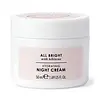What's inside
What's inside
 Key Ingredients
Key Ingredients

 Benefits
Benefits

 Concerns
Concerns

 Ingredients Side-by-side
Ingredients Side-by-side

Hibiscus Sabdariffa Flower Extract
Skin ConditioningButylene Glycol
HumectantWater
Skin ConditioningGlycerin
HumectantCetyl Ethylhexanoate
EmollientCaprylic/Capric Triglyceride
Masking1,2-Hexanediol
Skin ConditioningCetyl Alcohol
EmollientGluconolactone
Skin ConditioningCapryloyl Salicylic Acid
ExfoliatingXanthan Gum
EmulsifyingHydrogenated Lecithin
EmulsifyingEthylhexyl Palmitate
EmollientHydroxyacetophenone
AntioxidantCarbomer
Emulsion StabilisingAmmonium Acryloyldimethyltaurate/Vp Copolymer
Potassium Hydroxide
BufferingGlyceryl Acrylate/Acrylic Acid Copolymer
HumectantDimethicone
EmollientCyanocobalamin
Skin ConditioningHibiscus Sabdariffa Flower Extract, Butylene Glycol, Water, Glycerin, Cetyl Ethylhexanoate, Caprylic/Capric Triglyceride, 1,2-Hexanediol, Cetyl Alcohol, Gluconolactone, Capryloyl Salicylic Acid, Xanthan Gum, Hydrogenated Lecithin, Ethylhexyl Palmitate, Hydroxyacetophenone, Carbomer, Ammonium Acryloyldimethyltaurate/Vp Copolymer, Potassium Hydroxide, Glyceryl Acrylate/Acrylic Acid Copolymer, Dimethicone, Cyanocobalamin
Water
Skin ConditioningGlycerin
HumectantPrunus Amygdalus Dulcis Oil
Skin ConditioningDimethicone
EmollientCetearyl Alcohol
EmollientCetearyl Olivate
Sorbitan Olivate
EmulsifyingSodium Polyacrylate
AbsorbentHibiscus Sabdariffa Flower Extract
Skin ConditioningButyrospermum Parkii Butter
Skin ConditioningPhenoxyethanol
PreservativeXanthan Gum
EmulsifyingDimethicone Crosspolymer
Emulsion StabilisingCaprylyl Glycol
EmollientParfum
MaskingSodium Hyaluronate
HumectantSodium Benzoate
MaskingCitric Acid
BufferingEthylhexylglycerin
Skin ConditioningDipropylene Glycol
HumectantTetrasodium EDTA
Tocopheryl Acetate
AntioxidantBenzoic Acid
MaskingDehydroacetic Acid
PreservativeWater, Glycerin, Prunus Amygdalus Dulcis Oil, Dimethicone, Cetearyl Alcohol, Cetearyl Olivate, Sorbitan Olivate, Sodium Polyacrylate, Hibiscus Sabdariffa Flower Extract, Butyrospermum Parkii Butter, Phenoxyethanol, Xanthan Gum, Dimethicone Crosspolymer, Caprylyl Glycol, Parfum, Sodium Hyaluronate, Sodium Benzoate, Citric Acid, Ethylhexylglycerin, Dipropylene Glycol, Tetrasodium EDTA, Tocopheryl Acetate, Benzoic Acid, Dehydroacetic Acid
 Reviews
Reviews

Ingredients Explained
These ingredients are found in both products.
Ingredients higher up in an ingredient list are typically present in a larger amount.
Dimethicone is a type of synthetic silicone created from natural materials such as quartz.
What it does:
Dimethicone comes in different viscosities:
Depending on the viscosity, dimethicone has different properties.
Ingredients lists don't always show which type is used, so we recommend reaching out to the brand if you have questions about the viscosity.
This ingredient is unlikely to cause irritation because it does not get absorbed into skin. However, people with silicone allergies should be careful about using this ingredient.
Note: Dimethicone may contribute to pilling. This is because it is not oil or water soluble, so pilling may occur when layered with products. When mixed with heavy oils in a formula, the outcome is also quite greasy.
Learn more about DimethiconeGlycerin is already naturally found in your skin. It helps moisturize and protect your skin.
A study from 2016 found glycerin to be more effective as a humectant than AHAs and hyaluronic acid.
As a humectant, it helps the skin stay hydrated by pulling moisture to your skin. The low molecular weight of glycerin allows it to pull moisture into the deeper layers of your skin.
Hydrated skin improves your skin barrier; Your skin barrier helps protect against irritants and bacteria.
Glycerin has also been found to have antimicrobial and antiviral properties. Due to these properties, glycerin is often used in wound and burn treatments.
In cosmetics, glycerin is usually derived from plants such as soybean or palm. However, it can also be sourced from animals, such as tallow or animal fat.
This ingredient is organic, colorless, odorless, and non-toxic.
Glycerin is the name for this ingredient in American English. British English uses Glycerol/Glycerine.
Learn more about GlycerinThis extract comes from the Roselle flower, or Hibiscus Sabdariffa. Roselle flowers are rich in antioxidants.
Studies found the antioxidants in Roselle flowers to potentially help reduce UV-B damage.
Water. It's the most common cosmetic ingredient of all. You'll usually see it at the top of ingredient lists, meaning that it makes up the largest part of the product.
So why is it so popular? Water most often acts as a solvent - this means that it helps dissolve other ingredients into the formulation.
You'll also recognize water as that liquid we all need to stay alive. If you see this, drink a glass of water. Stay hydrated!
Learn more about WaterXanthan gum is used as a stabilizer and thickener within cosmetic products. It helps give products a sticky, thick feeling - preventing them from being too runny.
On the technical side of things, xanthan gum is a polysaccharide - a combination consisting of multiple sugar molecules bonded together.
Xanthan gum is a pretty common and great ingredient. It is a natural, non-toxic, non-irritating ingredient that is also commonly used in food products.
Learn more about Xanthan Gum